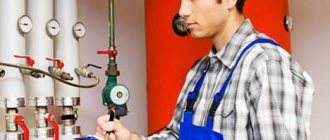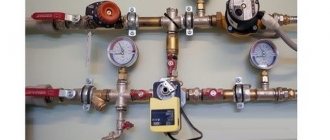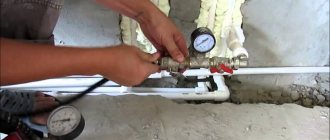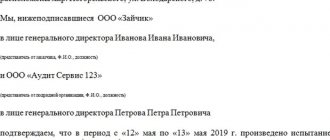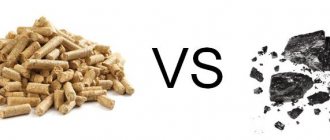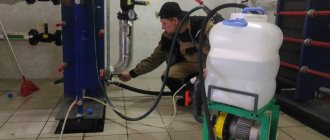Flushing heating systems
Hydropneumatic flushing of heating systems is a mandatory measure when preparing the heating system for start-up before the start of the heating season.
Water circulates through a closed circuit of the heating system during the heating period, and when heated and cooled, hardness salts are deposited. And this, together with the processes of corrosion of the internal walls of the pipes, leads to the deposition of scale on them. Scale significantly reduces the internal cross-section of pipelines, increases the hydraulic resistance of the system and reduces the heat transfer of radiators.
In high-temperature heating systems, scale leads to local overheating and further formation of fistulas. Scale deposits one millimeter thick lead to a reduction in heat transfer from the heating system by 15-20%. And on a global scale, this means colossal losses of thermal power and a significant decrease in the energy efficiency of the system with a significant increase in the cost of heating the building.
Flushing heating systems is the same necessary annual event as pressure testing, and is carried out before the start of the heating season or at the time of commissioning.
The main sign of a “clogged” heating system is an increase in coolant consumption, an increase in warm-up time, or uneven heating of the radiators. In these cases, situations often arise when the pipelines are hot, but the radiators are not yet warmed up.
The hydropneumatic method involves filling the system with clean water and connecting an air compressor to it. Excessive air pressure increases the flow rate of the coolant and creates turbulent fluid flows. These flows in places of scale deposits create vortex vibrations, as a result of which contaminant particles are torn off the surface of the walls.
When supplying high pressure air, the valve on the air bleed valves must be closed, and a check valve must be installed to protect the compressor from water entering the system.
Also, for flushing the system, there are special solutions that break down the scale deposited on the walls of pipelines and thereby reduce their hydraulic resistance.
Features of dismountable flushing of the heat exchanger
If the heat exchanger is very dirty or completely out of order, dismountable flushing can help. The rules and technology for dismountable washing are quite simple. It is necessary to disassemble the heat exchanger, remove all the plates, soak them in a special solution, wash each plate manually, and insert the package of plates into the heat exchanger. After this, the heat exchanger is assembled and pressure tested.
By following the rules of this work, you will receive many benefits:
- dismountable heating flushing guarantees the highest quality;
- any contamination is eliminated;
- everything happens clearly, and you can see the entire work process.
However, there are also disadvantages that cannot be avoided, even if you follow all the rules of work. So, if your heat exchanger has been worn out, under critical conditions, or the service life of the rubber seals has expired, then you may have to change the heat exchanger seals, which will increase the cost and duration of the work.
- in the case of dismountable washing, it is sometimes possible to remove contaminants using a jet of water from a special high-pressure apparatus;
- If there are more serious deposits, you must first clean the heat exchanger plates from the top layer of deposits using a high-pressure apparatus, then soak them in an acid solution, and then clean them again using a high-pressure apparatus.
The essence and types of crimping
Nowadays heating is most often carried out by a “water circuit” system. At the same time, heated water circulates through the works, imparting its thermal energy to the premises. Leaks are unacceptable; the pipeline must be completely sealed for normal operation. Pressure testing specifically creates a larger volume in the pipe than normal.
When this is done using air, it is called pneumatic pressing.
When using water, then hydropressing. The latter method is considered safer and therefore more popular. For this reason, an example of hydropressing is provided as a form.
When testing, it is recommended not to exceed the pressure inside the pipe more than 15 MPa. If we are talking about raising pressure with water, then there are limitations. The maximum possible pressure should not exceed the normal operating pressure by more than 30%.
In multi-storey buildings they resort to pneumatic pressure testing if the pipes are very old and there is a risk of flooding. But then there is a level of risk and all residents must be notified of the tests being carried out.
The work process is simple, but multi-stage. The algorithm looks like this:
- The necessary materials and equipment are being prepared.
- Draining the liquid that was previously in the heating system.
- Uploading a new one.
- Create the highest possible test pressure.
- Taking control measurements after 10 minutes.
- Flushing, adjusting the heating system to normal pressure levels inside.
- Documentation of work performed, generation of reports and acts.
But this is how the list of procedures looks only if there are no “thin spots” in the heating system and, accordingly, the tightness in it is not broken. If the pressure drops quickly and does not hold, then the system needs repair work. In such a situation, the specialist performs the necessary actions (replacing the pipe, sealing connections, cleaning, etc.), and then begins crimping from the very beginning. Only a heating system that has passed the test is allowed into the heating season.
Important nuance! Pressure testing should be carried out after cleaning and flushing the pipes. Otherwise, salt and other deposits inside them can mask possible external damage and breakthroughs.
If there are deposits of about 1 cm on the inner surface, then this reduces the overall heat transfer and efficiency by 15 percent or more of the overall indicators. To document the cleaning, a special report is also drawn up.
In what cases is it compiled?
The act is required when:
- Commissioning of new equipment. The certificate will confirm that each element is in its place, the installation was carried out responsibly, and the system is working.
- The heating season is approaching. After a summer break in work, the pipes could fail. After checking their capacity, a report is drawn up.
- Already carried out repair work.
- The occurrence of contained emergency situations on the pipeline. In this way, specialists identify the amount of work required and the weak points of the existing heating network.
For the uninterrupted operation of the heating system, preventative control checks and reliable information about the quality functioning of the system upon startup are necessary.
Components of the heating system pressure test report
What and how to flush the heating system and batteries
At the top left is information about the organization that carried out the inspection. Ideally, there should be a signature for approval by the chief power engineer of the heating supply organization.
The top right should contain subscriber information. That is, about who is the client and consumer of heating services. This could be a partnership of residents of a particular house, any organization that occupies the building, the owner of a private house, etc.
It is important to provide names and other information accurately and in detail. In this case the address is required
The main part of the act states:
- City.
- The date of signing the act (and the pressure test itself).
- Heat supply organization: its form of ownership, name, full name of the representative.
- Which of the subscriber's representatives accepted the heating system after the test: full name, position.
- To what indicators the pressure in the system was raised is indicated in kgf/cm2.
- To what indicators did it drop after 10 minutes following the shutdown (the units of measurement here are also kgf/cm2, it is also permissible to measure it in mPa if accurate data on this matter is available).
- Whether the system passed or failed the test (the person completing the form needs to highlight the correct option).
The final part consists of the signatures and seals (if any) of the representatives:
- Subscriber.
- Heat supply organization.
- Service organization.
In general, the act of pressure testing the heating system is a convenient primary document, for filling out which the heat supply organization is responsible.
Is it possible to wash a separate battery?
Now you know how to flush the heating system. However, sometimes it becomes necessary to clean a separate battery. There is a solution for this situation too.
Buy a flushing faucet from a plumbing store. Additionally, you need to purchase a rubber hose and a fitting with a thread that matches the diameter of the purchased flushing valve. Install the fitting onto the hose.
Direct washing is carried out in the following sequence.
First step. We connect the flushing tap to the heating radiator.
Second step. We connect a fitting with a hose to the flushing tap.
Third step. We direct the second end of the rubber hose into the toilet.
Fourth step. Open the flush tap and leave for 20-30 minutes. While waiting, hold the hose so that it does not jump out of the toilet.
Methods for cleaning radiators
Chemical cleaning method for heating systems
During the chemical cleaning of parts of heating systems, their internal cavity is filled with special solutions. These include substances made from acid or alkali. They contain inhibitors. They are able to prevent metal corrosion, help preserve its internal part, and extend its service life.
heating systems. During work, old alkali and acid solutions should be drained. Such solutions are quickly neutralized. Acid components of an alkaline solution are added to them. This cleaning method is used when washing steel pipes. The composition of the reagents cleans the inside of the battery from rust and salt deposits.
Cleaning heating systems using hydraulic pneumatics
This method of cleaning the heating system is recognized as the most universal, inexpensive and most popular. This cleaning method requires using a lot of water. In autonomous heating systems, all internal parts are washed only with cold water.
Flushing sequence
using hydraulics:
- start the heating system in reset mode;
- a stream of air is directed to the coolant of the system, which will quickly clean the internal structures of the battery from scale and formations;
- if there are risers in the heating system, then they are washed; if the heating system is cleaned by the tenant himself, then the risers should be washed individually. This is done in order to flush the radiator itself.
According to the drawn up agreement, and this is necessary to check the quality of flushing, it is necessary to carry out control coolant intakes
. Such work is carried out in the thermal unit, in other parts of the system. This is done for the equipment acceptance committee, which will sign the equipment acceptance certificate. She can always make sure the water is clean and free of impurities.
The topic of this article is documentation of flushing the heating system. We are interested in drawing up an estimate, concluding a contract and drawing up a report.
In addition, the criteria by which the work performed is assessed are also interesting.
When the system should be cleaned
The system will require an initial flush after installation to remove any remaining flux or pipe joining material, as well as any metal particles such as swarf left over from recent installation or changes to the piping.
If the system is properly maintained, well designed, and regularly treated with a corrosion inhibitor, unscheduled flushing is unlikely to be required unless significant changes are made to the system.
However, not all of these requirements are common and sludge can build up in the system very quickly. Here are a few clues that indicate that sludge has already begun to accumulate in the heating system:
- cold “spots” on the bottom of radiators;
- parts of the heating circuit that do not heat up correctly;
- Excessive noise (bumps, clicks, pops) made by the boiler when it heats up.
The heating circuit should also be thoroughly flushed before installing a new high-efficiency condensing boiler, as the heat exchangers in such boilers are particularly susceptible to damage from contaminants in the heating system.
General information
Before cleaning, you should check the system to determine its configuration. You also need to determine the “age” and general condition of the components in order to select the required system flushing mode. For example, the procedure may remove corrosive debris blocking openings in radiators, which can lead to coolant leaks. If there is any doubt as to whether the system will withstand any cleaning methodology, replacement or repair of the relevant components will be required before proceeding.
Cleaning procedure
There are several ways to clean a system and there are a number of cleaning products on the market designed to help flush heating systems. Many products are designed to be added to the circulating water some time before flushing and help mobilize contaminants prior to flushing. Here you need to follow the instructions from the manufacturer of these products.
Basic flushing procedures:
- Powerflushing.
- Overpressure flushing.
- Flushing with a circulation pump
Positive pressure flushing is probably the most effective procedure (although it is important to check the boiler manufacturer's instructions to determine whether flushing the system using the boiler in the heating circuit is acceptable). Powerflushing is also an effective method for cleaning heating systems, especially those containing high levels of black magnetite sludge.
Powerflushing is also an effective method for cleaning heating systems, especially those containing high levels of black magnetite sludge.
Please note that with all methods, changing the direction of coolant flow will help remove debris that could otherwise remain in the system and cause it to fail.
Preparation
Before flushing with any method, there are several general preparation steps. Typically these involve adding a suitable detergent to a running heating system and letting it sit for some time before actually flushing. The cleaner is usually flushed (while hot) from the system and the system is primed to begin the final flushing process.
Before flushing, you may also need:
- Turn off all electrical controls and electrically isolate the system.
- Avoid supplying cold water to the central heating system.
- Manually close all heating circuit vents.
- For systems with open ventilation, close or temporarily connect the open ventilation and cold water supply to the supply and expansion tanks.
- When draining a vented system, the collection tank may have quite a large portion of floating sludge. It must be removed to prevent it from being drawn into the pipeline.
- Mark the operating position of any shut-off valves or other control valves, and then open all valves fully.
- Remove all thermostatic radiator valve (TRV) heads to ensure maximum flow through the valves.
- Set any diverter or zone valves to their manual open position.
- Where check valves are present, they must be closed, bypassed or temporarily removed, otherwise this will prevent flow reversal.
How and how to flush radiators and heating systems
The process of cleaning the heating system of a house is not complicated; any owner can handle it.
There are several ways to clean the heating network in a private home with your own hands.
:
- mechanical flushing;
- dry cleaning;
- hydropneumatic flushing;
- pneumohydraulic hammer method;
- biological washing.
Mechanical flushing
This method of flushing heating systems requires complete disassembly of all communications - before cleaning the elements, you will have to remove every part of the system. The complexity of the method lies in cleaning the internal surfaces of pipes and batteries from scale and rust manually using metal brushes. Nowadays, it is practically not used, as it requires a significant investment of time and effort.
Chemical washing method
To clean the system, you need to connect a pump with a container filled with chemicals. The detergent dissolves and loosens contaminants stuck to the pipe walls.
For chemical cleaning, two types of liquids are used - acid or alkaline based, used depending on the material from which the pipes and batteries are made, as well as the type of deposits. It is recommended to flush the heating system with chemicals also in cases where it is too difficult to remove the system elements.
Alkali- or acid-based cleaning fluid cannot be used when working with aluminum batteries due to the fact that the metal reacts with chemical compounds. It is also prohibited to clean depressurized systems, since the chemical cleaning agent is toxic and can cause harm to health.
. For the same reason, used liquids should not be poured down the drain, and work should be performed with rubber gloves and a respirator.
After chemical cleaning, all contaminants will be completely removed, extending the life of the system.
Hydropneumatic flushing
This method involves treating the internal surfaces of batteries and pipes with a flow of a mixture of air and water supplied under high pressure. Flushing the heating system in this way is highly effective, but its use requires special equipment.
Hydropneumatic cleaning has proven itself excellent when working with cast iron radiators of the old type, still made in the Soviet Union. Cleaning with water and air does not impose any strict requirements on the elements of the heating system, like a chemical method, that is, it is equally suitable for all types of materials and pipes. Despite the high cost compared to the chemical method, it is completely safe and more effective.
Before cleaning, it is recommended to treat batteries using a special composition that softens the crust of contaminants.
Pneumohydraulic hammer method
This method is the fastest (takes no more than an hour), convenient, since you do not have to dismantle the elements of the system, but requires the use of special equipment.
At the end of the heating communications, special equipment is attached - a pneumatic gun, with the help of which a pneumohydraulic pulse is supplied to the pipeline, peeling off pollutants adhering to the walls of pipes and batteries.
Despite the serious and frighteningly complex name, flushing pipes in this way is absolutely safe, since a force of no more than 2% of the pulse power is applied to the walls, and the main impact falls on the dirt.
Biological washing
At its core, this method is very similar to the chemical one, only instead of dangerous reagents, high-tech solvents and proppant biological products are used. Under their influence, the crystalline bonds of pollutants are destroyed and corrosive and organic deposits are cleaned off.
The flushing biomaterial is produced on a water basis, and their use allows you to completely clean the heating network in an apartment building and in an individual home.
Causes of clogged heating pipes
The water contains many additional components. The most predominant are iron, calcium and magnesium. When exposed to relatively high temperatures, they are released in the form of small fractions that settle on the inner surface of pipes and radiators.
Therefore, before washing aluminum radiators, you need to find out the nature of the contamination. In addition to calcium and magnesium deposits, oxide deposits can form due to natural rusting of metal heating components. Depending on the nature of the contamination, the optimal cleaning technology is selected.
Usually the plaque includes the following elements:
- Iron oxides. In a system with steel pipelines and radiators, they can occupy up to 25% of the total plaque volume;
- Calcium and magnesium deposits occupy up to 60%;
- Oxides of copper, sulfur and zinc – up to 15%.
Since the heating radiator in an apartment should be flushed only after a preliminary analysis of the nature of the contamination, it is recommended to first take a plaque sample. To do this, you can dismantle part of the pipeline. In practice, this is not always done, especially for heating systems installed relatively recently.
Heating system pressure test certificate
This document displays the following information:
- What type of crimping method was used?
- The project in accordance with which the circuit was installed;
- The date of the inspection, the address where it was carried out, as well as the names of the citizens who sign the act. This is mainly the owner of the house, representatives of the repair and maintenance organization and heating networks;
- How the identified faults were eliminated;
- Test results;
- Are there any signs of leakage or reliability of threaded and welded connections? In addition, it is indicated whether there are drops on the surface of the fittings and pipes.
Procedure for cleaning pipes yourself
To clean the heating system pipes with your own hands using chemicals, you need to know how to flush the heating system and follow a certain sequence of actions:
- The system must first be thoroughly examined to determine which solution to use for cleaning.
- Next, carefully study the instructions for the selected chemical. The solution must be prepared in strict accordance with the specified recommendations, since each preparation has a certain consistency.
- Fill the pump reservoir with the prepared solution and connect the device to the system.
- It is necessary to ensure that the chemical is moving through the system.
- Wait a certain period of time, which depends on the degree of contamination and its composition.
- At the end of flushing, remove the chemical solution from the system, rinse it thoroughly and fill it with clean water.
What is crimping
There is a misconception among people that if the heating is assembled correctly, then it will work well and for a long time. This is partly a correct thought, but do not forget that for the system to function flawlessly, it must be tested before launching.
The heating unit is checked using pressure testing. Pressure testing is a set of works that helps to check the heating for leaks.
There are two types of crimping:
- Using compressed air. Using a compressor, compressed air is supplied to the heating device to a certain pressure value. After this, radiators, pipes and stopcocks are monitored for depressurization.
- With the help of water. This method differs from the first in that instead of air, water is supplied into the pipes from a hydraulic pump. Water is also supplied to a certain pressure value. This is also followed by checking the tightness of the device components.
It should be noted that both methods are effective and allow you to fully test all heating units for leaks. During the inspection period, using pressure testing, you can quickly identify flaws in the heating device and eliminate them, which allows you to avoid unpleasant incidents during the heating season.
Conclusions and useful video on the topic
You can see how to flush a heating system that consists entirely of heated floors in this video. The chemical washing method was not chosen by chance, because other options are almost impossible to implement with so many tubes, connections and bends:
Cleaning a separate radiator using the hydropneumatic method is shown and described here:
When choosing a flushing method for your heating system, try to find a balance of convenience, cost and safety for both the pipes and the environment. Remember that it is up to you to live with this system and repair it in the coming years.
How often do you flush your heating system? Do you use the services of professionals or do it yourself? Which washing method do you prefer? Join the discussion on the topic in the block below the article.
What is pressure testing of heating and water supply systems?
Heating and water supply are two systems consisting of a large number of varied equipment. As you know, the performance of any multicomponent system is determined by the weakest element - if it fails, it stops completely or partially. To identify all weak points, pressure testing of heating and water supply is carried out. In simple terms, the pressure deliberately rises much higher than the working one, pumping liquid. This is done using special equipment; the pressure is controlled using a pressure gauge. The second name for crimping is hydraulic testing. It's probably clear why.
Heating pressure testing is carried out after any repair or before the heating season
When a heating system is pressure tested, the pressure is increased by 25-80% depending on the type of pipes, radiators, and other equipment. It is clear that such a test reveals all the weak points - everything that does not have a safety margin breaks, leaks appear in worn pipes and unreliable connections. Having eliminated all identified problems, we ensure the functionality of our heating or water supply for some time.
If we are talking about centralized heating, then pressure testing is usually carried out immediately after the end of the season. In this case, there is a decent period of time for repairs. But this is not the only case when such events are held. Pressure testing still takes place after repairs or replacement of any element. In principle, this is understandable - we need to check how reliable the new equipment and connections are. For example, you soldered heating from polypropylene pipes. We need to check how high quality the connections are. This can be done using crimping.
If we talk about autonomous systems in private houses or apartments, then a new or repaired water supply is usually checked simply by turning on the water, although even here a strength test would not hurt. But it is advisable to test the heating “to its fullest”, both before commissioning and after repairs. Keep in mind that those pipelines that are hidden in walls, floors or suspended ceilings must be tested before they are closed. Otherwise, if during testing it turns out that there are leaks there, you will have to disassemble/break everything and fix the problems. Few people will be happy about this.
Concentrates
DIXIS LUX
The drug is diluted with water (preferably soft or rain) in a ratio of 1 to 9. The product is suitable for heat transfer surfaces made of ferrous metal, stainless steel, and copper alloys.
Price: from 1530 rub./10 l.
DIXIS LUX
pros
- low price;
- neutralizing solution included;
- You can drain the used product into the sewer;
- quick rinse (2.5 hours);
- Contains only organic acids, acid corrosion inhibitor.
Minuses
the required temperature of the working environment is 60...70 °C.
DIXIS LUX
ARGUS SUPER POWER
Before use, the concentrate should be diluted with 10-15 liters of water, depending on the degree of contamination. Contains a corrosion inhibitor. Operating temperature for effective cleaning is 20...40 °C.
Price: from 1200 rub./4 l.
ARGUS SUPER POWER
pros
- low cost;
- color indicators;
- corrosion inhibitors;
- low operating temperature.
Minuses
- has a characteristic odor;
- there is no information about the possibility of draining liquid into the sewer.
ARGUS SUPER POWER
Heat Guardex Cleaner 824R
The product is intended for cleaning the circuit in a heating system running on antifreeze. The product is diluted in a ratio of 1 to 30.
Price: 6400 rub./l.
Heat Guardex Cleaner 824R
pros
- highly concentrated substance;
- Effectively removes sludge and glycol residues.
Minuses
high price.
Heat Guardex Cleaner 824R
TELAKKA HEAT
1 liter of concentrate is diluted in 3–5 liters of water. The product is suitable for flushing systems with plastic and rubber tubes. The product is safe for sealants. The working temperature of the solution is 20...35 °C.
Price: from 1600 rub./5 l.
TELAKKA HEAT
pros
- operates at relatively low temperatures;
- contains anti-corrosion components;
- safe for rubber seals;
- without smell;
- does not contain mercury, chlorine, heavy metals and other harmful components;
- When combined with waste water, it does not form toxic or explosive compounds.
Minuses
- not suitable for products made of aluminum, non-ferrous metals and stainless steel;
- quite high cost.
Telakka HEAT heating system cleaner
SYNTILOR Watesup
This professional product is suitable for washing pipes made of plastic, metal alloys, and rubber. Requires prior testing when used in stainless steel equipment. Requires dilution in 5–15 liters of water. The solution does not destroy seals.
Price: from 450 rub./l.
SYNTILOR Watesup
pros
- operates at low temperatures 20...35 °C;
- does not destroy rubber, plastic;
- does not affect the structure of metals;
- provide protection of metals from oxidation;
- has no pungent odor;
- without mercury, heavy metals, chlorine.
Minuses
- not suitable for cleaning aluminum and aluminum-based alloys;
- relatively high cost.
SYNTILOR Watesup
SYNTILOR Watesup All
The product is intended for flushing heating systems made of aluminum. The product does not destroy seals. Before use, it is recommended to dilute in 5–15 parts of water.
Price: from 480 rub./l.
SYNTILOR Watesup All
pros
- the preparation can also be used for different types of steels, including stainless steel (after a preliminary test);
- the solution is compatible with plastic and rubber pipes;
- does not contain mercury, heavy metals, or other harmful impurities;
- without smell;
- effective at temperatures 20...35 °C.
Minuses
not noticed.
SYNTILOR Watesup All
Hydraulic test procedure
The procedure and rules for conducting hydraulic testing of the heating system are regulated by the following regulatory documents:
- SNiP 41-01-2003 “Heating, ventilation and air conditioning”;
- SNiP 3.05.01-85 “Internal sanitary systems”;
- Rules for the technical operation of thermal power plants, developed by the Ministry of Fuel and Energy of the Russian Federation, approved in 2003.
Important points in the hydropressing procedure
- Responsibility for conducting hydraulic testing lies with organizations that maintain and operate heating networks. In multi-apartment buildings - a management company, a utility service represented by specially trained and certified employees who have the necessary permits and certified equipment, or a representative of an energy supply company with appropriate authority. In administrative, social and industrial facilities - employees of the organization performing maintenance of such buildings. In private homes - a foreman, technician or engineer of an energy supply or specialized company.
- Testing of the heating system and thermal units must be carried out separately. Therefore, the circuit is disconnected from the heat source, expansion tank and main water supply line.
- The system should be filled with water having a temperature of no more than 45 0C. In this case, the test pressure must be ensured at the top point of the circuit, for which it is necessary to completely bleed air from it.
- The pressure rises in two stages: to standard operating pressure, which is recommended to be maintained for some time, but not less than 10 minutes, to inspect all elements for leaks; If there are no defects, its value is adjusted to the test value.
- The minimum pressure value during hydrotesting will depend on the standard operating indicator in each specific scheme (as a rule, it should exceed the operating value by 25-50%) and will be: - test pressure - 0.2 MPa; - when using cast iron radiators - 0.6 MPa; - when using convector or panel devices - 1.0 MPa; - for an elevator unit - 1.0 MPa.
- The tests are considered completed and the system is pressurized if:— within 5 minutes the pressure drop in the water circuits does not exceed 0.02 MPa;— after 15 minutes of testing the panel heating, the pressure decreased by no more than 0.01 MPa;— when checking strength and tightness of a polymer pipeline, the drop value within 30 minutes does not exceed 0.06 MPa;—there is no formation of “sweating” at the joints, seams, joints.
- The main document confirming the fact that a hydraulic test has been carried out in full compliance with the standards is a report, which must be correctly filled out and signed by authorized persons.
The act of flushing heating systems. Sample of filling out the document and methods of carrying out work
Flushing of heating systems is carried out by specialized organizations after the preliminary conclusion of an appropriate agreement. Upon completion of the work, a heating system flushing report is drawn up. The sample and appearance of this document depend on the complex of activities carried out by specialists.
Mandatory procedure
Heating systems are a set of equipment (pumps, boilers, pipelines and radiators) designed to heat rooms.
Due to the fact that heated water is usually used as a coolant, all parts from the inside are covered with a dense layer of contaminants. Sometimes in pipes such deposits reach more than fifty percent of the cross-section.
This reduces heat transfer and lowers the temperature inside the room itself. There are two ways to combat this phenomenon:
- replacing individual parts of the heating circuit;
- flushing the system.
The second option is considered more preferable, since it does not require serious constructive interventions. After carrying out the necessary set of measures, a heating system flushing report must be drawn up, a sample of which specialists have in the form of prepared forms.
They do not have to be ordered from a printing house. To do this, you can use any printing device. How to fill out the heating system flushing report? The sample is usually a standard text in which individual fields that are required to be filled out are deliberately omitted.
It is usually compiled by a representative of the organization involved in the cleanup. What does the act of flushing heating systems look like? A sample form begins with its name and date of preparation. The following information is presented sequentially:
- Address of the object.
- Information about the three obligatory participants in whose presence this procedure takes place (customer, representative of the service company, specialist from the cleaning organization).
- Date of work.
- From four options, you select the method by which the system was cleaned.
- Water meter readings before and after work. The amount used and temperature are indicated separately.
- The quality of the work performed.
All data specified in the act ends with the signatures of three parties.
Hydropneumatic flushing
This flushing technique has been used by the domestic housing office for more than a decade, therefore, it is quite effective. Of course, if everything is done correctly.
Video guide
Video air gun Typhoon
Carrying out this procedure is quite simple: water is discharged from the system first on the return line, then vice versa. In this case, the water flow must be “adjusted” with a powerful pneumatic pump. Strong pressure will remove deposits and scale and carry them out of the system.
Regarding the mentioned housing office, the flushing of the heating system, which is carried out by its employees, looks something like this:
- the return valve is closed;
- a pneumatic pump is connected to the valve, which is located after the valve;
- the “return” is reset;
- after the pressure in the pump exceeds 6 kilograms per square centimeter, the valve to which it was previously connected opens;
- all risers are blocked in turn, but so that no more than ten are blocked at the same time; Only if all these conditions are met will the washing be carried out extremely effectively.
The time that the procedure will take can be easily determined by eye, taking into account the degree of contamination of the heating system. New risers begin to be cleaned only after the water from the previous ones comes out completely purified
After flushing all the risers, the system is switched to discharge in the opposite direction.
- the discharge closes, as does the valve to which the air pump was connected;
- the open valve is also closed, after which a similar one on the “return” is opened;
- the system is reset - the device is connected to the valve in the reverse direction, the valve opens, and the device turns on.
The next steps of the procedure are the same as in the previous version, only the water will move in the other direction.



